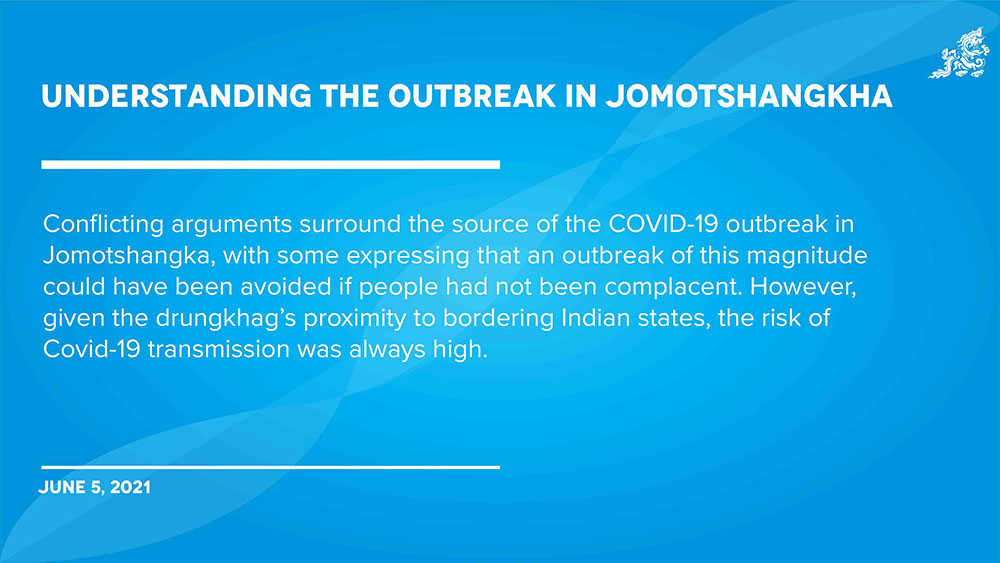More than two weeks after the detection of eight cases from Jomotshangkha Drungkhag in Samdrupjongkhar, the hunt for a potential source of the biggest outbreak of Covid-19 in the country is on.
The drungkhag that claimed to be ready for any potential outbreaks of Covid-19 some 14 months ago is today, besides Phuentsholing, one of the hotspots of the ongoing outbreak in the country.
There are conflicting arguments that the virus was first introduced into the community by the highlanders of Merak. However, those in the highlands say otherwise and claim that the highlanders picked up the infection from the people of Lauri gewog in Samdrupjongkhar.
A few villagers suspect security personnel could have been the source since they were also present in Khashateng chiwog under Merak gewog in Trashigang. According to sources, the event was apparently the main channel of transmission of the virus into the communities.
Connecting the dots
Jomotshangkha is located in a tri-junction of Bhutan, Assam, and Arunachal Pradesh of India in the south-eastern part of the country.
Given its proximity to the bordering Indian states, Jomotshangkha Drungpa, Lamdrak Wangdi, said that the risk of Covid-19 transmission was always high. “In anticipation of possible outbreaks, we had set up multiple patrol outposts along the international border covering more than 70km.” He said that given the higher risk, the majority of the 26 outposts were concentrated along the southern borders. The outbreak, however, happened from the northern part of the drungkhag.
On May 21, eight individuals from Jomotshangkha — one from Phajo Goenpa in Lauri gewog, six from Jomotshangkha Royal Bhutan Army (RBA) cantonment area, and one from Jomotshangkha town — tested positive for Covid-19, triggering a complete lockdown of the drungkhag.
All eight individuals were the primary contacts of the 60-year-old highlander who tested positive in Merak, Trashigang on May 19.
According to sources, the highlander came to Khashateng chiwog from the jungle, where he and other highlanders were herding their cattle. The highlander also attended the same bereavement event in the chiwog days before the outbreak.
The highlander was said to be sick, who was then locally treated in the village.
The bereavement event was also attended by people from Phajo Goenpa in Lauri Gewog, Samdrupjongkhar.
Majority of these people who had attended the event later tested positive starting with the highlander who was detected with the virus before entering the main Merak village.
Although Khashateng chiwog is under Merak gewog, given its proximity to Lauri gewog, the chiwog was considered a high-risk area and anyone travelling from the chiwog were subjected to seven days quarantine and checking before entering Merak and other villages at Serkimla.
With neither Merak nor Sakteng gewogs reporting any local cases from the community (main village), it is believed that the highlander and his contacts who later tested positive could have picked up the virus while herding their cattle or from the event in Khashateng chiwog.
The area where the highlanders keep their cattle is near Arunachal Pradesh. Informal trade has also been happening across the border over the years.
Sources said that either the highlanders could have crossed the border illegally and contracted the disease or it could be the people in Lauri and Serthi gewogs, who also share a border with Arunachal Pradesh, already infected through cross-border illegal interactions.
“Whoever brought the virus, it was the event in Khashateng that contributed to the transmission of the virus in all the other communities,” said a source.
Drungpa Lamdrak Wangdi said that while the transmission of the disease could have had happened someday, an outbreak of this magnitude could have been avoided if people were not complacent.
He said despite constant reminders to avoid gatherings, the event in Khashateng attracted a huge crowd. A nungney (religious fasting event) in Serthi gewog was conducted without formal approval from the respective authorities, which in turn contributed to the current community transmission.
The drungpa said that despite setting outposts to keep check of any illegal trespassing across the border, it was impossible to guard the entire area constantly. “Because the borders are very porous, there are significant gaps between two outposts, some of which stretch over 3km. And with only three people manning the outposts, it is difficult to monitor all movements.”
Officials from the technical advisory group said that while the Covid-19 virus could enter from any direction, the government’s focus so far had been more towards the southern borders and urban areas.
In the process, officials said, they could have overlooked some of the safety measures in places like Jomotshangkha and Merak, which are also high-risk areas given their close proximity to the border.
Officials also said that while it was difficult to trace the source of infection in an outbreak, it was necessary to investigate in order to avoid subsequent outbreaks in the future.
In the meantime, Lamdrak Wangdi said that the situation in Jomotshangkha was under control for now. “During the initial days of the outbreak, we did struggle with shortage of manpower and medical equipment including testing kits.”
Today the drungkhag has set up separate isolation facilities in the three gewogs including a temporary hospital at the drungkhag office manned by a pediatrician and a medical specialist.
By Younten Tshedup
Edited by Jigme Wangchuk


